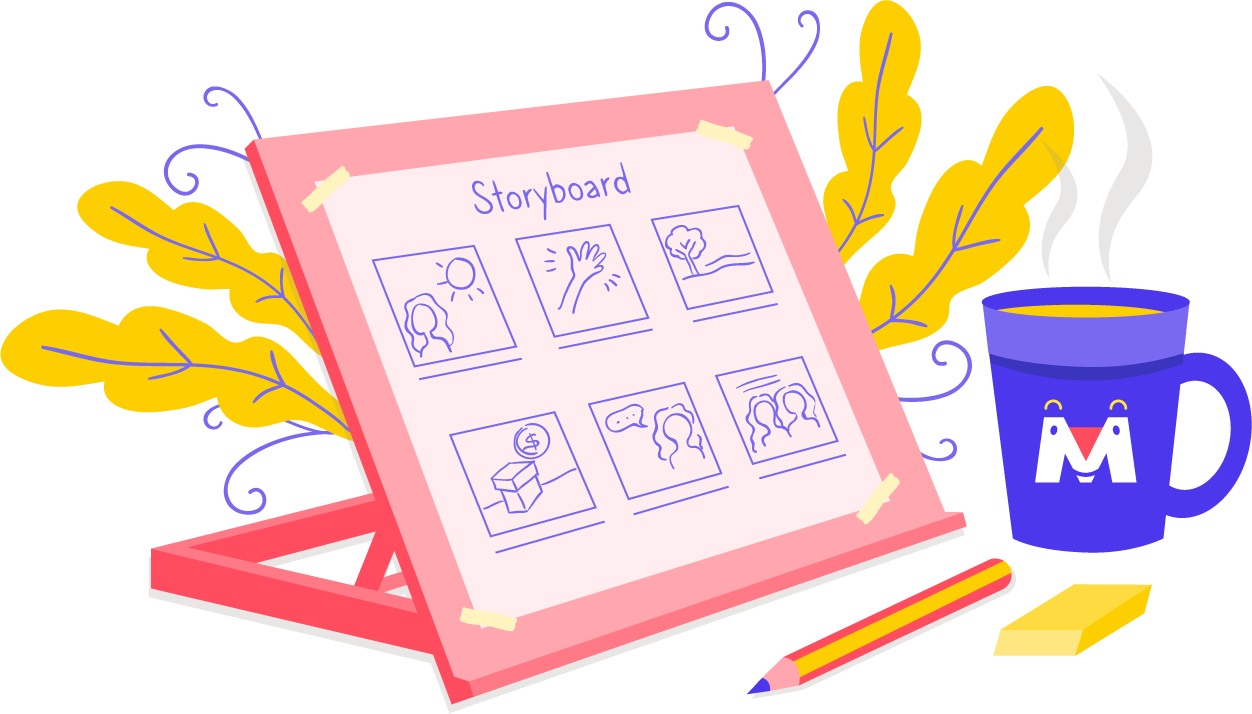
Storyboarding stands as a pivotal phase where creatives can experiment with the flow of the narrative, ensuring that each visual element aligns perfectly with the intended message. This not only guarantees that the story unfolds coherently but also allows the brand’s voice to resonate clearly with its audience. In this process, the abstract concepts of marketing strategies and campaign goals take on a tangible form, paving the way for impactful storytelling that captivates viewers.
As we peel back the curtain on this artistic endeavor, we’ll explore how the meticulous craft of storyboarding at Marmonaut is not just about drawing pictures—it’s about translating the essence of a brand into a visual language that speaks volumes.
What is Storyboarding?
Storyboarding, in the realms of animation and film production, is akin to creating a comic strip for a cinematic piece—it is the process of sketching out scenes in sequence to pre-visualize a motion picture, animation, motion graphic, or interactive media sequence. This method involves drawing the scenes of a video, frame by frame, providing a visual layout of events as they are to unfold on screen. Each board may detail a particular shot, encompassing aspects like camera angle, motion, timing, and the transition to the next shot, serving as a roadmap for production.

Tracing its roots back to the early days of cinema, storyboarding was popularized by Walt Disney Studios during the 1920s and later adopted by other film studios. The technique became indispensable in the planning of animated features, allowing directors to see a full story at a glance and make crucial narrative decisions before costly animation began. Alfred Hitchcock, known for his meticulous direction, further championed storyboarding in live-action filmmaking, meticulously planning every frame to control the suspense and rhythm for which his films are renowned.
From Disney’s pioneering animations to Hitchcock’s thrilling masterpieces, storyboarding has evolved to become an essential tool in visual storytelling. Today, it remains an integral part of the creative process in Marmonaut’s production, ensuring that every visual tale told is both captivating and strategically sound.
The Process of Creating a Storyboard
Creating a storyboard is a meticulous and creative process that transforms a script into a visual guide. Here’s how the Marmonaut team approaches this task:

1. Script Analysis
Every storyboard begins with a deep dive into the script. The team dissects the narrative, identifying key scenes and moments that will need visual representation.

2. Thumbnail Sketches
These rough sketches are the storyboard's first visual form. They are quick and basic, focusing on composition and major elements of each scene.

3. Adding Details
Once the basic structure is set, the sketches are refined with more details, including character positions, expressions, and important props.

4. Incorporating Camera Angles and Movement
The team then decides on camera angles and movements that best tell the story, ensuring dynamic and engaging visuals.

5. Dialogue and Notes
Each frame is annotated with relevant dialogue (or voiceover) and action notes, providing a comprehensive guide for the production team.

6. Review and Revision
The storyboard is reviewed and revised as needed. This iterative process ensures that every aspect of the story is captured effectively.

7. Finalization
The completed storyboard serves as the visual script for the production, guiding the filming or animation process.
The Marmonaut team emphasizes the importance of storyboarding as a collaborative and flexible process, one that allows for creative exploration while keeping the project aligned with the client’s vision and goals.
Tips for Effective Storyboarding
Creating an effective storyboard is a blend of artistry and strategic planning. Here are some expert tips from Marmonaut to enhance your storyboarding process:
- Start with a Clear Vision: Understand the story you want to tell and the message you want to convey. A clear vision guides the storyboard in the right direction.
- Focus on Key Moments: Identify and emphasize crucial scenes that drive the story forward. Not every detail needs to be storyboarded, but pivotal moments should be highlighted.
- Keep it Simple: Early drafts should focus on composition and basic elements. Overcomplicating early stages can hinder flexibility and creativity.
- Consistent Flow: Ensure a logical sequence and maintain consistency in terms of characters and settings to avoid confusion.
- Incorporate Feedback: Be open to suggestions and revisions. Feedback can provide new perspectives and enhance the story.
Common Pitfalls to Avoid:
- Avoiding Details: While initial stages should be simple, the final storyboard needs enough detail to guide production effectively.
- Ignoring Timing: Overlooking the timing of scenes can lead to pacing issues in the final product.
- Rigid Adherence: Being too rigid can stifle creativity. Allow room for improvisation and adjustments as the project evolves.
Following these tips can lead to a more impactful and coherent storyboard, ensuring the final video effectively communicates the intended message.

Conclusion: A Storyboard's Role in Bringing Your Vision to Life
In the grand tapestry of video production, a well-crafted storyboard is not just a tool; it’s the foundation upon which compelling visual stories are built. It’s where the abstract ideas of a brand’s message begin their transformation into engaging narratives that capture the hearts and minds of audiences. At Marmonaut, we pride ourselves on creating storyboards that are not only artistically sound but strategically aligned with our clients’ visions.

Have an idea you want to bring to life?
Our doors (and drawing boards) are open. Connect with us here to discuss how our storyboarding expertise can turn your concept into a visual masterpiece that resonates with your audience. Let’s start scripting your success story, one frame at a time!

